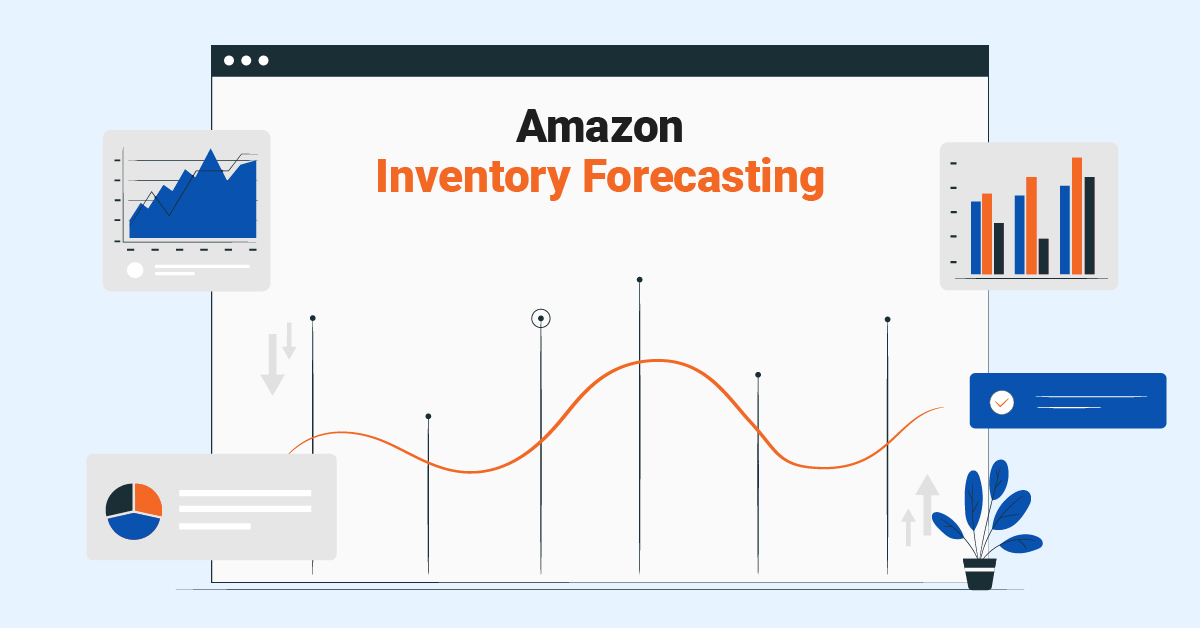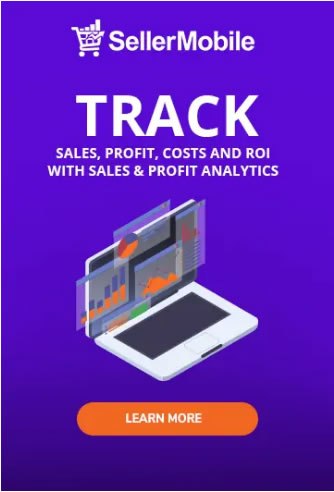As practice shows, 82% of online retail businesses fail because of cash flow problems.
And where are those problems coming from?
Since around 40% of cash is tied up in inventory (the stock businesses have in their warehouses to be ready for orders), we can say that a large portion of the problem comes from inventory management issues.
The amount of inventory you stock for a specific period equals the amount of cash you “freeze” in the warehouse. If you know that stored inventory will soon turn into revenue, that’s a healthy investment. However, if stock sits there for a long time, you tie up cash with it and risk the item becoming obsolete or unsellable, leading to additional losses.
So, the key question you should answer before deciding on the quantity of stock to keep is: what will my demand for specific items be?
This question can’t be answered without robust Amazon inventory forecasting, which is the process of predicting the demand for inventory based on historical data, trends, and other relevant factors.
So, in this guide, we’ll help you learn…
- What’s demand forecasting in inventory management
- Why you can’t survive without inventory planning and forecasting in the long run
- The best inventory forecasting software that can help you make accurate predictions

Why Amazon Inventory Forecasting Matters
While you can move with the wind and order stock based on your instincts, you’ll find this practice unsustainable as your business grows. Planning inventory without solid demand forecast data has a high risk of overstocking or understocking. Both situations damage your profit and can lead to a cash crunch.
With forecasting inventory management, you enjoy the following benefits.
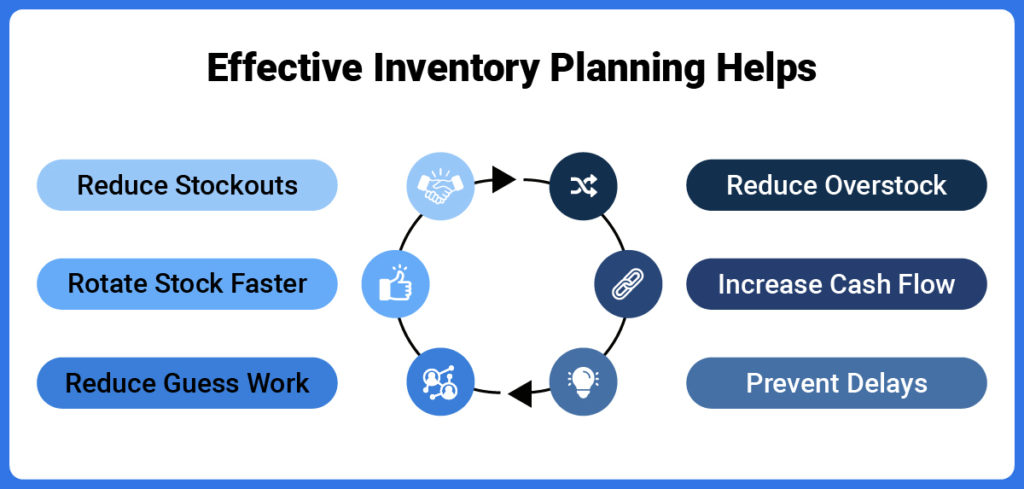
- Reduce overstock and understock because you know with high accuracy how much stock you need to order.
- Rotate stock faster because you know what sells and when, and you actually prepare for the existing demand.
- Prevent delays related to restocking orders or shortages, which leads to faster deliveries, happier customers, and boosted Amazon performance.
- Reduce guesswork – maybe a good gut feeling on a small scale, but a fine line on the edge when you expand your business.
Let’s discuss the importance of Amazon sales forecasting in a bit more detail.
Avoiding Overstocking and Understocking Issues
Too much or too little – whenever your inventory levels do not align with your customer’s needs, that’s a problem. This means you either have too much stock sitting around in warehouses without selling, or you don’t have enough to meet customer demands, which means lost sales and poor performance on Amazon.
Overstocking occurs when you order more stock than you can sell within a certain time frame. This leads to cash tied up in stock, storage fees, and potential losses if the items become obsolete or unsellable due to market changes or trends.
On the other hand, understocking happens when you don’t have enough inventory to fulfill orders. This results in backorders, canceled orders and unhappy customers, which can damage your brand reputation and lead to negative reviews.
By forecasting inventory demand accurately, you can avoid these issues and keep your inventory levels in line with customer demand.
Basically, Amazon inventory forecasting tells you how much stock you need to order, when and for what products. And as you order based on statistical data backing up the prediction, your chances of overstocking or understocking are greatly reduced.
Reducing Inventory Holding Costs and Increasing Profit Margins
Unless you use your bedroom, garage, or any other personal space for storage, you’ll have to pay to keep stock in warehouses. Be it an Amazon FBA, a third-party warehouse, or your own storage space – the costs are there. The more inventory you have and the longer this inventory stays in the warehouse, the higher those expenses will be.
Keep in mind that inventory holding costs don’t include only storage fees, but also the salaries of those employees who maintain, handle and process your stock. You should also factor in depreciation costs for perishable items or those that may become obsolete.
In a nutshell, your overall inventory holding costs are calculated with this formula.

In general, inventory holding costs make up around 20-30% of the total costs of inventory. If, depending on your sales velocity (the speed at which products in your inventory get sold and leave the shelves), you keep high stock levels for a long period, you’ll see this percentage rise. This, in turn, means lower profit margins because of spending more on inventory holding costs.
With accurate inventory management and forecasting, you organize your inventory so that it does not stay in the warehouse for long without being sold. You have data-based suggestions on how much and from which SKUs to order so that your inventory levels remain optimal in relation to sales and your budget.
Enhancing Customer Satisfaction and Retention
A happy Amazon buyer is the one who gets what they want, when and how they want it. If you keep your stock levels in line with demand, you meet your customers’ expectations. And when their expectations are met, they are more likely to leave a positive review and return for future purchases.
When you use inventory planning and forecasting, you’re always up to date with stock levels and can fulfill orders in a timely manner. This involves not only regular cycles of stock replenishment but also some special occasions like demand spikes during holiday seasons, reserving stock when you run promotions that are likely to boost sales, etc.
So, with Amazon inventory forecasting, you learn the key insight that leads to customer satisfaction – their demand. Preparing for it, you deliver it and keep them happy.
Higher customer satisfaction is one of the key benefits of inventory forecasting. There’s no better business than the one that explores its buyers’ preferences and offers solutions tailored to their needs.
How Does Amazon Inventory Forecasting Work?
Before going into details, you should know there are two ways to do Amazon inventory forecasting.
- Using Amazon Forecast, where your own input, data collection and analysis are needed (a harder solution).
- Using specialized inventory forecasting tools like SellerMobile, where your input in terms of data, integration and monitoring is minimized (an easier solution).
But before we move to what’s easy, let’s see how Amazon itself organizes the process of forecasting inventory demand.
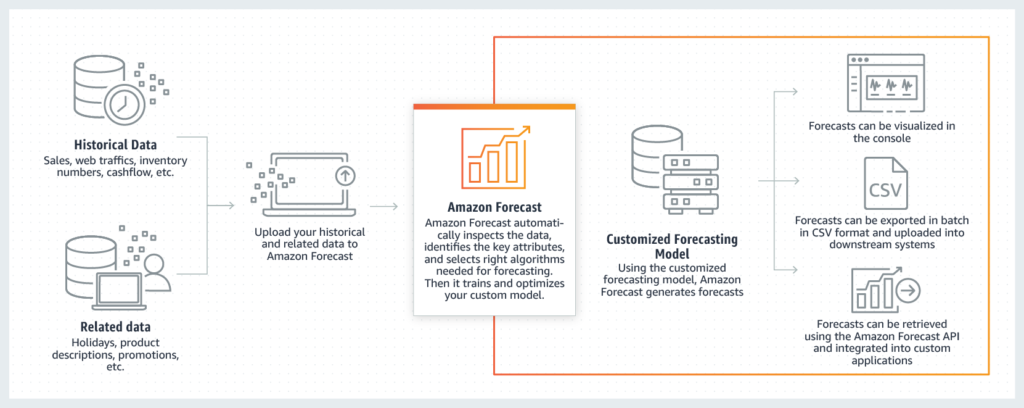
Source: Amazon.com
A Fully Managed Service
Amazon does not analyze your inventory on its own. It creates a customized forecasting model based on the detailed inspection of data you upload to Amazon Forecast.
So, you’re expected to initiate the process by importing historical data of your sales, traffic, cash flow, and some related data like product descriptions, promotions, etc., for the system to analyze which algorithms are best suited for your business.
Once the processing is done, Amazon creates your custom forecasting model to give you predictions about retail demand, supply chain and resource planning, etc.
Amazon does all of these based on its time-series forecasting principles.
Use Time Series Datasets to Generate Forecasts
When Amazon Forecast gives you a forecast, you can view it in the console to derive insights or export it in batch in CSV format to upload into downstream systems.
If you know how to use APIs, AWS Command Line Interface, Python or similar programming language, you’ve got a great opportunity to leverage the forecasting model in your own systems and get Amazon inventory forecasting for your inventory planning.
But If You Don’t Want to Enter into Manual Data Management…
Specialized inventory forecasting tools come to the rescue. You can get insightful and actionable suggestions on what, how much, and when to order by simply connecting your Amazon Seller Central account with a specialized tool.
Interested in how to do that?
Let us tell you!
Inventory Management and Forecasting with SellerMobile
Well, what if you’re just great at producing and selling but you’re not a data specialist who can figure out the complicated use of Amazon Forecast?
You do the following steps.
- Create a Seller Central account (or use the one you already have for running your Amazon business).
- Create SellerMobile account
Link those two together, after which SellerMobile will start tracking your sales, traffic, and inventory data and providing insights about your stock’s state without you raising a finger.
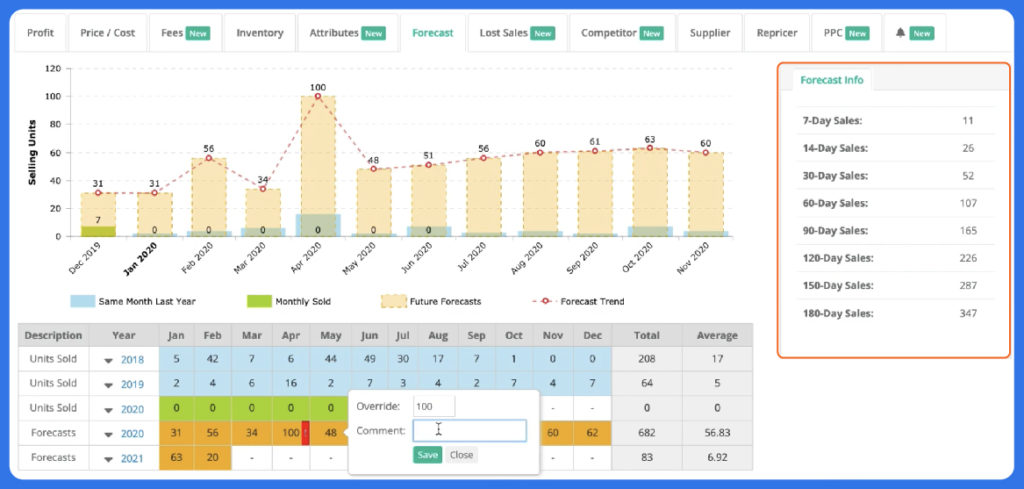
SellerMobile is designed to simplify heavy data analysis and help Amazon sellers get the most out of their business. Its inventory forecasting features automatically extract your Seller Central data and suggest you restock quantities by computing your historical sales, inventory levels and seasonality.
Unlike Amazon, SellerMobile does not require you to manually import data, handle APIs, or program your own forecasting model. You only need to connect your Seller Central account with SellerMobile and get Amazon inventory forecasting that helps you make better decisions for a successful business.

Forecast Demand with Advanced Algorithms
Here’s how SellerMobile works to help you with Amazon inventory forecasts.
In the “Forecast” section of your SellerMobile dashboard, you can easily see your past, present, and future sales on one screen. These numbers are here with SellerMobile’s advanced algorithms analyzing how much of a certain SKU you’ve sold on a daily, weekly or monthly basis for the last periods.
Further, using some insights into customer behavior and your historical sales, SellerMobile forecasts the future demand of each SKU, giving you a friendly window with suggestions of when to restock, how much to restock, and even which supplier you’re recommended to buy from.
So, what do you do with these suggestions?
SellerMobile lets you generate purchase orders based on the forecasting inventory management calculations, so you instantly send a PO to your supplier and make sure you replenish stock on time.
And even if you’re not logged in in SellerMobile, but a specific SKU goes out of stock, SellerMobile notifies you about the danger of not having a product in stock, so you act quickly.
So, a non-stop data analysis and forecasting process is happening in SellerMobile for you to have a successful business. Meanwhile, your only manual input is regularly checking your restock suggestions dashboard and ordering products on time, as SellerMobile advises.
See Consolidated Amazon Inventory Forecasting Data in One Screen
Besides restock suggestions, you get all-in-one inventory analysis data in SellerMobile’s unified dashboard. That’s a unique spot to check all the inventory-related information about your Amazon business without navigating through Seller Central from page to page.
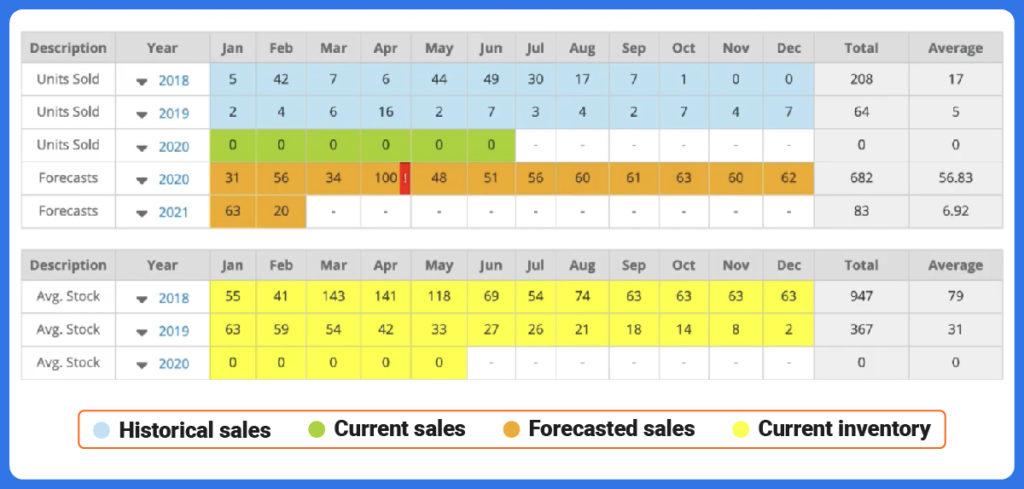
As you can see from the screenshot above, SellerMobile shows you what you’ve already sold and what you’re currently selling side by side. Further, it shows you how much you can expect to sell in the future vs. your current inventory level for a particular SKU.
That’s the simplest and most convenient way to see what needs an extra boost in terms of inventory planning- just by looking at one screen.
Check more about SellerMobile’s inventory management and forecasting in the video below.
Seasonal Trends and Adjustments
Though it’s great that SellerMobile runs inventory planning and forecasting for you, it’s your personal business and there are general trends that the software can’t spot.
That’s why you can always use its human overriding feature to add certain insights that SellerMobile uses in your demand calculations.

For example, you see SellerMobile advises you to restock a certain amount of an SKU based on previous sales, but you know you’re planning a large promotional campaign for that SKU which is likely to generate 100 more units of sales for the month.
What you do is go to the “Forecast” section and add a custom adjustment of a hundred units in addition to what SellerMobile suggests.
The software will instantly incorporate that information and update your demand forecast numbers based on those extra sales.
Similarly, you can manually add supplier lead times based on the time of the year, seasonality, world events, etc. This will help SellerMobile understand that a specific supplier takes longer to deliver during the holiday season, for example.
Consequently, when making restock suggestions, SellerMobile will advise you to order specific SKUs sooner, so you have enough inventory during busy times.

Check how to override inventory forecast predictions in SellerMobile in the detailed video guide below.
Real-Life Success Story: How Demand Forecasting in Inventory Management Helped This Seller’s Business
Jeremy Adams is an Amazon seller that boosted his business with SellerMobile’s Amazon inventory forecasting.
Forecasting inventory demand is his favorite SellerMobile feature, which allows him to easily check previous sales data and learn from it without manually importing data or using complicated formulas.
Jeremy enjoys breaking down historical data month by month, week by week, or even day by day, as this helps him adjust his inventory planning strategies accordingly and minimize excess inventory.
He never had an issue of running out of products during seasonal peaks thanks to SellerMobile’s robust reports that show him how much inventory is needed for each SKU.
“I have the reports from last year letting me know exactly how many units I’ve sold. I don’t have to go through and check different databases to see how much I need. It’s all right at my fingertips and it makes my ordering process a lot smoother with a lot more sales,” says Jeremy.
Conclusion
Blind strategies and a lack of data analysis can lead to stockouts, overstocking or incorrect restocking decisions. As an aspiring Amazon business owner who wants to scale their business, you can’t afford such mistakes.
Your best advisor and the most reliable base for Amazon inventory forecasting is your historical sales data. When you have your previous sales performance documented, you can see what’s invisible to the human eye – the insights and trends of your target audience’s demand over a particular period.
With modern inventory forecasting tools that automate the entire process of collecting and analyzing your historical sales data, no excuses are left for not having successful and steady inventory management and forecasting.
SellerMobile – an Amazon inventory management and forecasting software, is a cloud-based solution that helps you maintain the optimal level of inventory without manual work.
It connects to your Seller Central account, collects all the necessary data, and provides you with the most accurate restock suggestions.
What’s your role here?
Just sign up for your best partner in Amazon’s success and follow regular restock suggestions coming your way.

